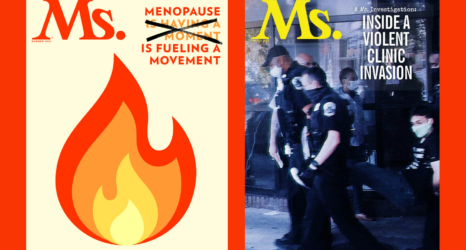This March, for Women’s History Month, the Ms. Blog is profiling Wonder Women who have made history—and those who are making history right now. Join us each day as we bring you the stories of iconic and soon-to-be-famous feminist change-makers.
This interview was first published in the Winter 2013 issue of Ms. Click here to get a copy!
On Jan. 22, 1973, the U.S. Supreme Court decided 7–2 in Roe’s favor, thus assuring women in this country the legal right to abortion. We celebrate the 40th anniversary of that ruling with both joy and vigilance, knowing that our reproductive rights have been almost constantly under attack since then, and remain in jeopardy. But what better person to ask about the legacy of Roe, and what we must do to keep its protections intact, than that “genteel Southern lady”—or, as we prefer to think of her, that fierce feminist warrior—Sarah Weddington.
Though she gained a permanent place in history 40 years ago, Weddington’s work for women didn’t stop after she argued the case for Roe. She went on to serve in the Texas state Legislature, worked as an assistant to President Jimmy Carter and was his point person for women’s issues, and has been a university professor, a speaker and an author. Her rousing 1992 memoir, A Question of Choice, has been updated and republished this year by The Feminist Press.
We started our Ms. Conversation by asking about the recent presidential election.
Ms.: Do you look at each presidential election as being crucial for the survival of Roe v. Wade, since the president might get to change the composition of the Supreme Court?
Sarah Weddington: Yes. Particularly the ones in which Bill Clinton was running, and then Obama. Obama’s position on choice and reproductive freedom was so diametrically opposed to Romney’s. And you look at the ages of the justices and just think that in the next four years there is a real possibility there will be some vacancies, and who gets confirmed becomes critically important in Supreme Court decisions because the court is so evenly balanced [between conservatives and more liberal justices]. And now, of course, elections at the state and local level become very important, too—not just to keep abortion legal, but for women to have access to abortion. Most of the groups that I know are now starting to have new strategies that really focus on the state legislatures and the bills that will be coming up there.
Ms.: How frustrating has been the endless backlash against Roe v. Wade over these last 40 years?
SW: I thought that we would not have to keep fighting that fight over and over and over, and there would be other things that we would move on to. I never foresaw that [abortion] would be one of the biggest issues in the 2012 election. I am angry in a way, but anger doesn’t do any good.
Ms.: You wrote in your book about your frustration with having to play half-court instead of full-court basketball as a girl growing up in Texas. I wonder if there is a metaphor there.
SW: Oh yeah. I often say that women were trying to create a wider space to make their own decisions. Whether it was about their work, or whether they could run for office, or play sports, or get credit, or [obtain] contraception or abortions—there were so many issues where women were told, “Women can’t. Women don’t. Women shouldn’t.” When I was in high school, women were allowed to run only half-court in basketball and make two dribbles, so I talked to the coach about it, and she would say, “Oh, no, all that bounding and jiggling and rebounding—why, you would hurt your innards. And that is your meal ticket.” And it was one of the reasons I was determined to have a different meal ticket.
Ms.: You were just 27 years old when you argued Roe v. Wade—your youth and inexperience should have made you the least likely person to do this. Yet what made you the right person?
SW: It was a time when we were so furious about the way women were treated. In college, the dean had told me women could be nurses, secretaries or teachers—but I couldn’t go to law school. And I said, “But I have wonderful grades.” And he said, “It’s just not a career for women.” So of course I went to law school. Or, I wanted to run for vice president or president of the student body at McMurry University in Abilene, Texas, and the dean had said, “Oh no, you can’t do that, women have to be the secretary.” And so I did run for secretary, but my suite mate and I decided we would run my boyfriend for vice president and her boyfriend for president—and since they weren’t quite as passionate about issues as we were, we would really run the university from our suite.
Because I hadn’t been able to get a job with a law firm, I didn’t have any real experience. I had done one adoption for my uncle, some divorces for people with no real assets to divide up, a couple of wills for people with very little money. I had not done Big Law. And at the point when I started the Roe v. Wade case, I also didn’t realize it would become the U.S. Supreme Court case. I thought I was part of this movement to build a pyramid of cases all over the country and to help boost some other case to the Supreme Court. So I was startled when I got the notice that the Supreme Court would accept our case and to “get ready.”
Ms.: You also had personal experience with abortion that further inspired your efforts.
SW: When Ron Weddington [her ex-husband, who also helped work on the Roe v. Wade case] and I were in law school, I had an unplanned pregnancy, and so we went to Mexico. And I thought later how lucky I was, because I had the money and Ron knew a woman who had the information. The doctor in Mexico, while it was illegal, was really a very competent and caring person.
One of the problems we have now is state laws [that] cut off access to abortion or make it very difficult, especially for poor and younger women—as well as for all women who don’t want to have to travel to another state for their abortion.
Ms.: On the day that Roe was decided, you wrote in your book, the momentum of the forces for and against legal abortion began to reverse.
SW: It felt to me before Roe v. Wade that the movement [for the right to abortion] had been becoming more and more effective, more and more determined. Then once Roe was decided, the antis suddenly said, “We gotta start working,” so they became much more active. Those who were pro-choice, pro-reproductive-freedom thought, “Well that’s been solved. Now we can go work on these other issues.” So the momentum, the passion, the determination switched sides.
Ms.: It seems that we are always on the defensive against all these awful anti-choice laws that states are passing. What can we do to strengthen reproductive rights?
SW: I think there will be more focus on getting out and supporting candidates who believe in our positions and who will stand up. In the last legislative session here in Texas, the Legislature was considering a bill that would require a pregnant woman who wanted an abortion to have a sonogram. A young member of the Legislature from Houston, Carol Alvarado, brought in a vaginal probe and said, “This is what you are talking about.” And the man who intro-duced the legislation said, “Well, I don’t know anything about that.” And that was the whole point—he didn’t know anything about that.
Ms.: Do you think that Roe was decided before there was more of a national consensus on the legal right to abortion—as the anti-abortion forces like to say?
SW: Once Roe was decided, beginning on Jan. 22, 1973, there was instant availability of safe and legal abortion. If the argument is we should have waited, well, no telling how long that would have taken—and it would have meant that women would have still faced that same old back-alley or self-abortion situation. Even if the consensus has been stronger since Roe, I wouldn’t have wanted to wait for that decision.
The truth is, even if a state could pass a law making abortion immediately illegal, a whole lot of women would choose self-abortion or illegal abortion. You used to have in most states IOB wards—infected obstetrics wards—where doctors were trying to save the fertility, the lives, of women who were infected as the result of illegal abortions. There are still something like 70,000 women worldwide who die each year from illegal abortions.
Ms.: You’ve never stopped working to keep Roe intact, even though you already made your mark on history.
SW: Sometimes it really feels weird when people introduce me as being historic, and yet I realize it is part of history. And it is an important history for all those women in the last 40 years who got to make their own choice. That’s the principle I want us to preserve. We will wish in the new year and future years that Roe v. Wade will be strengthened, that the ability of state legislators to pass bad bills will fade and that women will continue to be able to make their own choices.
Ms.: I understand you have on your wall a signed photo of the justices who ruled on Roe v. Wade.
SW: You have to pay for the picture, and the judges will sign as a courtesy. And sometimes people will say, “Well gee, can you get one of those if you lose?” And I say, “I don’t know. I have never lost a case in the Supreme Court.”
Get Ms. in your inbox! Click here to sign up for the Ms. newsletter.
Photo via Wikimedia Commons





